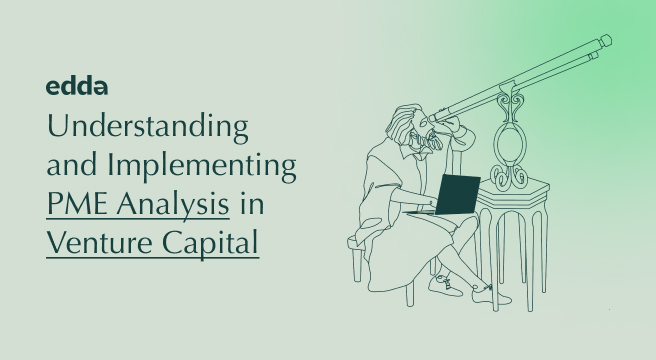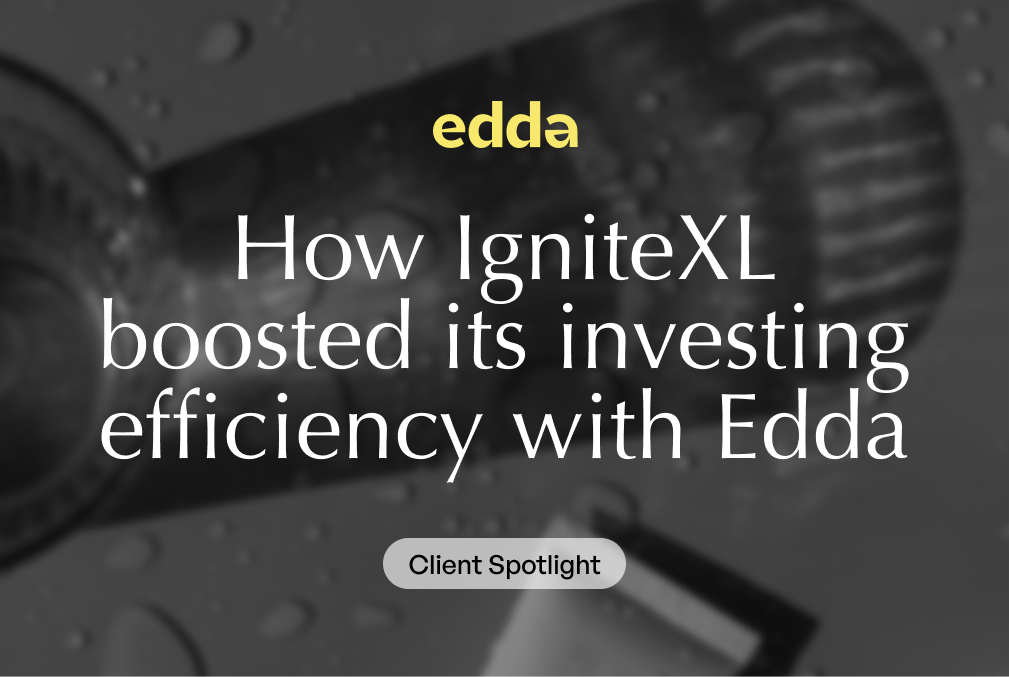The venture capital (VC) landscape is laden with tools and methodologies that help both seasoned and budding investors evaluate and measure the performance of their investments. One such powerful metric is the public market equivalent (PME) analysis. In this article, we’ll explore what PME is, its significance, and how it can be effectively utilized in the realm of venture capital. In addition, discover how Edda’s software venture capital suite can be a major asset to your firm.
What is PME Analysis?
The public market equivalent is a refined financial tool developed to offer a direct comparison between the returns on private investments (like venture capital or private equity) and public market investments. In its essence, PME evaluates the question: If the capital committed to a private investment was instead invested in the public market, would its performance be superior, equal, or inferior?
The PME Formula
PME is calculated by determining the ratio of the present value of all distributions from the private investment to the present value of all capital calls, considering the public index’s performance.
PME = ∑ (Distribution at time t) × (Public Index factor at time t) /
∑ (Capital call at time t) × (Public Index factor at time t)
Where the Public Index factor is derived from the relevant public market index’s growth.
Significance of PME in Venture Capital
Basis for Comparison
Venture capital, by its very nature, ventures into uncharted territories, often funding disruptive startups that don’t have straightforward benchmarks. PME provides a structured comparison by benchmarking against public markets. By offering a side-by-side comparison with public markets, which are often more familiar to a wider audience, PME translates the otherwise abstract performance of VC investments into more accessible terms.
Holistic Perspective
While metrics like IRR or MOIC provide insights into the performance of an investment, they do not, in isolation, give a complete picture. By comparing VC returns to a public market index, PME brings an added dimension to the performance analysis. PME situates the returns of a private investment in the broader context of market trends, ensuring investors understand not just the raw numbers but also how these numbers fare in the larger ecosystem.
Enhanced Decision Making
When investors see how their private investments compare to potential public market returns, they can adjust their investment strategies, making tactical shifts when needed. By continually benchmarking against the public markets, investors can also gauge the risk they are taking with their VC investments relative to potential public market investments.
Applying PME in Venture Capital
An angel investor has invested $1 million in a tech startup. Over a span of 5 years, she receives distributions from the startup based on its growth and final exit. She wonders if her capital would have generated better returns if she had instead invested in the NASDAQ.
She decides to use PME analysis to answer her question. She calculates the net present value of her distributions using the NASDAQ returns over the same period as her discount rate. Simultaneously, she determines what her $1 million would have grown to if it had been invested in the NASDAQ.
If the PME value is greater than 1, it means her investment in the startup outperformed the NASDAQ. If it’s less than 1, the NASDAQ would have been a better investment. If it’s equal to 1, both investments would have yielded the same return. Using PME, she can now make more informed decisions for her future investment endeavors.
PME analysis bridges the divide between the often nebulous realm of private investments and the more transparent domain of public markets. By offering a clear benchmarking tool, PME equips investors with the insights they need to evaluate and refine their investment strategies continuously.
PME in Venture Capital vs. Private Equity
While PME is a tool that can be used across alternative investments, its application differs slightly between VC and private equity.
PME Venture Capital: Given the longer time horizon and often binary outcomes (either substantial success or failure), PME in VC requires a more speculative public benchmark. It might also involve greater volatility considering the start-up nature of the investments.
PME Private Equity: PE investments typically involve established firms, which means PME analysis in PE may involve more predictable cash flows and might align more closely with broader market indices.
Steps to Implement PME Analysis in VC
PME analysis offers a robust lens through which one can evaluate the performance of venture capital investments. However, given the unique nature of VC investments, it’s imperative to ensure meticulousness and nuance in its application. Here’s a more detailed breakdown of the steps to employ PME analysis effectively in the realm of venture capital:
Choosing the Relevant Benchmark
The startup or VC fund’s industry, stage, and geographic focus should influence your benchmark choice. For a tech startup in its early stages, a tech-heavy index might be more appropriate, while a late-stage health-tech VC might find a health-centric index more fitting. The chosen benchmark should mirror the volatility, risk, and potential return of the VC fund. This ensures that the comparison is contextually relevant and valid.
Gathering Data
Document all instances when the VC fund called for capital from its investors. These represent the investments or injections into startups or other avenues. Note down all returns that the VC fund provided to its investors. This could arise from exits, dividends, or other forms of distributions. Ensure that the data is consistent, capturing all monetary movements and spanning the entire life of the VC fund or investment.
Compute the Public Index Factor
For each time point when capital was called or distributed, calculate the growth factor of the public index. Essentially, this measures how much an equivalent investment in the public market would have grown by the given time. The cumulative growth factor, tracking from the beginning of the investment to each time point, helps in understanding the overall public market performance over time.
Apply the PME Formula
Using the capital calls, distributions, and the public index growth factors, input these values into the PME formula. The formula will weigh the distributions and capital calls by the public index’s performance, eventually providing the PME value, which is the heart of this analysis.
Interpret the Results
A PME value exceeding 1 is an optimistic sign, suggesting that the VC investment outpaced the chosen public market benchmark. Conversely, a PME value below 1 implies that the investment might have fared better had the capital been directed to the public market. It’s essential to interpret these results in the broader context of the VC fund’s strategy, goals, and market conditions. A PME value close to 1 in an extremely high-risk segment might still be deemed favorable, given the inherent uncertainties.
Considerations When Using PME
PME is an invaluable tool for comparing private investments to their public counterparts. However, its effectiveness is contingent on a meticulous approach, which involves addressing several key considerations:
Time Horizon
Venture Capital investments are renowned for their longer gestation periods, as startups transition from ideation to profitability. Thus, when employing PME analysis, it’s essential to ensure that the chosen public benchmark not only aligns in terms of duration but also encapsulates similar market phases and conditions. This ensures a like-for-like comparison.
Given the protracted timelines, it’s vital to recognize that VC investments may face short-term volatility, but yield returns in the long haul. Hence, PME analysis should ideally be approached with a long-term lens, focusing less on short-term fluctuations and more on overarching trends and outcomes.
Apples-to-Apples Comparison
One of the most crucial aspects of PME is ensuring the selected public benchmark genuinely mirrors the risk and return dynamics of the private investment. Using a low-risk public index for a high-risk VC investment, or vice versa, can skew perceptions and lead to erroneous conclusions.
It’s pivotal to ensure the chosen public index aligns with the specific industry, sector, and geography of the VC investment. For instance, a tech-focused VC investment should ideally be benchmarked against a tech-centric public index.
Limitations
- Not a Standalone Metric: While PME provides a wealth of insights, it should not be the sole determinant in gauging investment success. Using PME in isolation might omit certain nuances or specificities associated with a private investment.
- Beyond Quantitative Analysis: While PME offers a quantitative comparison, investments—especially in the VC realm—are influenced by numerous qualitative factors. These might encompass management expertise, market disruptions, regulatory shifts, or technological breakthroughs, which a numerical metric like PME might not fully encapsulate.
- Market Anomalies: PME’s dependence on public benchmarks also implies it’s susceptible to market anomalies or short-term disruptions in the public domain. Investors should remain wary of such anomalies when interpreting PME outcomes.
Conclusion
Edda’s VC and private equity solution stands at the confluence of finance and technological innovation. By harnessing the power of real-time data acquisition and analytics, it refines the PME analysis process, ensuring that investors get an accurate, in-depth, and up-to-date understanding of their investments vis-à-vis the public markets. The platform’s streamlined processes eliminate the cumbersome steps traditionally associated with PME computations, making the analysis not just rigorous but also expedient.
Furthermore, the software’s advanced analytics capability delves deeper than surface-level comparisons. It can unearth patterns, predict trends, and provide insights that might elude a manual analysis. This level of depth and precision is paramount, especially in sectors like private equity and venture capital, where the stakes are high and margins for error are slim.
For venture capitalists and private equity professionals—whether they are industry veterans with decades of experience or newcomers eager to make their mark—the combination of PME analysis with a state-of-the-art portfolio management tool represents a significant competitive advantage. It equips them with the insights required to navigate an increasingly complex investment landscape, make informed decisions, and maximize returns.
As the investment domain continues to evolve, those who harness the synergies between PME finance methodologies and digital tools like Edda’s PE and venture capital portfolio management software will be best positioned to thrive, adapt, and excel in the future.









